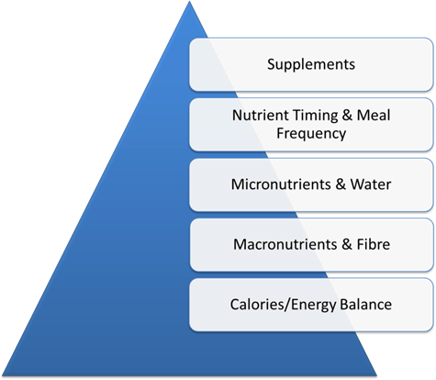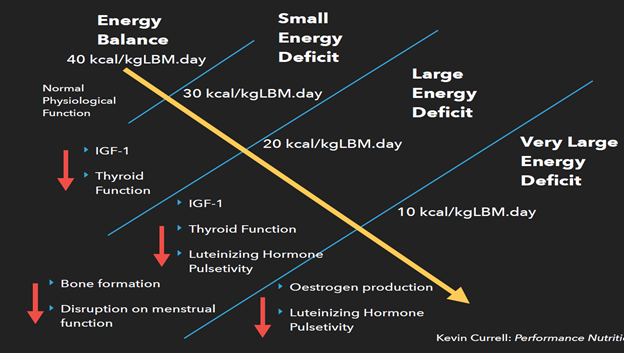Recovery is the return to a normal state of health, mind, or strength.
Optimal recovery is best attained through an integrative approach, focusing on nutrition, sleep, and stress management.
NUTRITION TO ENHANCE RECOVERY
Nutrition to enhance the recovery process should be prioritized as follows:
1. Energy balance/availability
2. Macronutrients
3. Micronutrients
4. Hydration
5. Nutrient timing
6. Supplements

ENERGY BALANCE & AVAILABILITY
Energy (calories) is the foundation of the repair process. Optimize your energy by focusing on the 3 Ts:
1. Total- Match your caloric intake with your training/activity requirements and goals.
2. Type- Focus on carbohydrates for energy and glycogen restoration, adequate-protein for repair and muscle protein synthesis, and healthy fats to minimize inflammation and support overall health.
3. Timing- Time your meals strategically around training sessions and competitions.
Energy availability (EA) is the difference between energy intake (diet) and energy expenditure (exercise, training and competing, and NEAT- Non-Exercise Activity Thermogenesis). It is essential for health, performance, and recovery.
Low Energy Availability (LEA) occurs when there is an imbalance between energy intake and energy expenditure, resulting in an energy deficit.
LEA can be unintentional, intentional, or psychopathological (e.g., disordered eating). It is a factor that can adversely impact reproductive, skeletal, and immune health, training, performance, and recovery, as well as a risk factor for both macro-and micronutrient deficiencies.

ENERGY AVAILABILITY FORMULA
Energy availability = (Energy intake (kJ) − Energy expenditure during exercise (kJ))/fat-free mass (kg)
(Ong, J. L., & Brownlee, I. A., 2017)
MACRONUTRIENTS
CARBOHYDRATES
Carbohydrates (CHO) are the primary energy source for moderate-intense activity. A general carbohydrate guideline is to match needs with activity:
● Low intensity/skill-based: 3–5 g/kg BW
● Moderate intensity: 5–7 g/kg BW
● High intensity: 6–10 g/kg BW
● Extreme: 8–12 g/kg BW
CARBOHYDRATES AND RECOVERY
During post-exercise recovery, optimal nutritional intake is essential to replenish endogenous substrate stores and facilitate muscle-damage repair and reconditioning. After exhaustive endurance-type exercise, muscle glycogen repletion forms the most critical factor determining the time needed to recover.
The postexercise carbohydrate (CHO) recommendations are 1 g/kg/ BW hour for four hours, then match activity needs (see above). This is the most critical determinant of muscle glycogen synthesis.
Since it is not always feasible to ingest such large amounts of CHO, the combined ingestion of a small amount of protein (0.2−0.4 g · kg−1 · hr−1) with less CHO (0.8 g · kg−1 · hr−1) stimulates endogenous insulin release. It results in similar muscle glycogen-repletion rates as the ingestion of 1.2 g · kg−1 · hr−1CHO.
Consuming CHO and protein (4:1) during the early phases of recovery has been shown to affect subsequent exercise performance positively and could be of specific benefit for athletes involved in numerous training or competition sessions on the same or consecutive days. (Burke, L. M. 2015) (Smith-Ryan, A., & Antonio, J. 2013) (Beelen, M. et al. 2010)
Carbohydrate dosing relative to resistance training should be commensurate with the intensity guidelines outlined above.
PROTEIN FOR RECOVERY
Optimum protein consumption is key to stimulating muscle protein synthesis and facilitating repair. Protein recovery guidelines for strength training include:
● Protein Dose: 1.6–2.0 g/kg BW
● 0.25–0.5 g/kg BW/meal in 4 divided meals
● Branch Chain Amino Acids- Leucine dose: 3 g is optimal to stimulate muscle protein synthesis (whey is a good source)
● The addition of 50 g of carbohydrate with protein pre and post-exercise can decrease muscle breakdown
● Consuming 1–2 small protein-rich meals in the first 3 hours post-exercise can capture the peak of muscle protein synthesis
(Dreyer, H. C., Drummond, et al. 2008) (Norton, L. E., & Layman, D. K. 2006) (Smith-Ryan, A., & Antonio, J. 2013) (Naderi, A. et al. 2016)
FAT
During the recovery process, fats are important as an energy source, hormone production, and inflammation reduction.
Essential Fatty Acid Balance
The Standard American Diet (SAD) is notoriously pro-inflammatory, with the Omega 6:Omega 3 greater than 4:1 (closer to 18:1).
To reduce inflammation and enhance recovery, athletes should focus on getting the fats in their diet from dark green leafy vegetables, flax/hemp seeds, walnuts, cold-water fish, grass-fed beef, omega-3 eggs; and limit omega-6 (vegetable and seed oils). Saturated fat should come from grass-fed, pasture-raised animals. Olive and avocado oils are good choices for cooking. (Simopoulos, A. P. 2008). Athletes should consume 20 to 35 percent of their calories from fat.
MICRONUTRIENTS AND PHYTONUTRIENTS
Micronutrients include vitamins and minerals. They are required in small quantities to ensure normal metabolism, growth, and physical well-being.
If your diet is 50-75% plant-based and includes healthy fats and adequate protein, you are likely to get the vitamins, minerals, and phytonutrients you need without having to rely on supplementation.
Phytonutrients, also called phytochemicals, are chemicals produced by plants. Phytonutrient-rich foods include colorful fruits and vegetables, legumes, nuts, tea, cocoa, whole grains, and many spices. Phytonutrients can aid in the recovery process due to their anti-inflammatory properties.
ANTIOXIDANTS- TOO MUCH OF A GOOD THING?
Reactive oxygen species (ROS) and reactive nitrogen species (RNS) are free radicals that are produced during exercise that can cause skeletal muscle damage, fatigue, and impair recovery. However, ROS and RNS also signal cellular adaptation processes.
Many athletes attempt to combat the deleterious effects of ROS and RNS by ingesting antioxidant supplements (e.g., vitamins A, C, E and the minerals Se and Zn). Unfortunately, interfering with ROS/RNS signaling in skeletal muscle during acute exercise may blunt favorable adaptations and can attenuate endurance training-induced. ROS/RNS mediated enhancements in antioxidant capacity, mitochondrial biogenesis, cellular defense mechanisms, and insulin sensitivity.
In addition, antioxidant supplementation can have harmful effects on the response to overload stress and high-intensity training, thereby adversely affecting skeletal muscle remodeling following resistance and high-intensity exercise.
The bottom line is that physiological doses (from the diet) are beneficial, whereas supraphysiological doses (supplements) during exercise training may be detrimental to one’s gains and recovery.
(Merry, T. L., and Ristow, M. 2016)
HYDRATION
Water regulates body temperature, lubricates joints, and transports nutrients. Signs of dehydration can include fatigue, muscle cramps, and dizziness. During the recovery phase, staying hydrated can help stimulate blood flow to the muscles, which can reduce muscle pain. In addition, hydration can help flush out toxins which can exacerbate muscle soreness.
ARE YOU DEHYDRATED?
- Clear – Good hydration, overhydrated to mild dehydration
- Pale Yellow – Good hydration or mild dehydration
- Bright Yellow – Mild to moderate dehydration or possibly taking vitamin
- Orange/Amber – Moderate to severe dehydration
- Tea/Apple Juice – Colored Severe dehydration
ENDURANCE SPORTS CONSIDERATIONS
● Early consumption of at least 150% of fluid lost with dilute sodium solution (</= 50 mmol/L, e.g., isotonic sports drink)
● Events greater than 90 minutes require pre-event hydration strategies 2–3 days prior (e.g., consume 400-600 mL of fluid every 2–3 hours containing Na 40–100 mmol/L)
● Aim to hydrate back to pre-race weight





